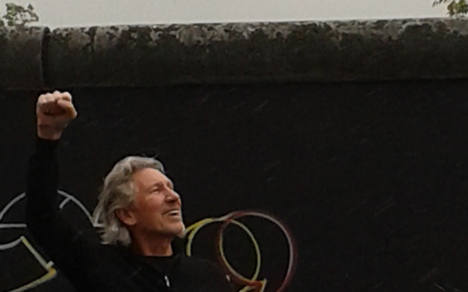Waters, 69 – former singer, bassist and lyricist of the British band Pink Floyd – found himself in hot water in recent days over his rock opera show “The Wall” which features an inflatable pig bearing a Star of David.
Jewish groups on Tuesday condemned the show as “anti-Semitic, cheap propaganda” and called for a boycott of Waters’ performances in Berlin and Düsseldorf this week.
Meanwhile, apparently left feeling comfortably numb by the whole affair, Waters visited Berlin’s East Side Gallery to lend support to a movement protesting the removal of sections of it to provide access to luxury riverside apartments.
“I’m not known for recommending the maintenance of walls in the world,” said Waters, who follows actor and singer David Hasselhoff in personally championing the cause.
“But in this case I’m extremely happy to make an exception. It’s a very beautiful and moving experience even to stand by it and remember all the fallen loved-ones from those dark days of the Cold War.”
“I see they managed to get the crane in before you could stop them,” Waters told the crowd, as behind him cranes and construction teams continued their work on the controversial luxury accommodation.
Earlier this year, demonstrators briefly succeeded in delaying removal of sections of the Wall, but were then outmaneuvered and a six-metre stretch of the gallery was removed to provide access for diggers and cranes.
Authors of a petition against the “Living Levels” project – a 63-metre-high tower block to be built on the narrow stretch of land between the Wall and the river bank – say the East Side Gallery should be conserved not only as a hugely popular tourist destination, but as a historical memorial to German division.
“We came because we wanted to see what the Wall really looked like and what it represents, it’s very thought-provoking,” Gayle, a passing British tourist on her first visit to Berlin, told The Local. “It wouldn’t be the same if it was in a museum,” she added.
Waters said he had spontaneously decided to sign the petition and publicly support the protest while in Berlin ahead of his show, which comes 23 years after Pink Floyd played their acclaimed 1979 The Wall album to an audience of 250,000 in July 1990 to mark the fall of the much-hated barrier.
Waters – who refused to answer questions during his brief visit to the Wall – has previously denied using anti-Semitic imagery in his show – a claim which has only further outraged German Jewish groups.
After an earlier complaint in Belgium, Waters, who turns 70 this week, denied in an open letter posted on his website that he was anti-Semitic and highlighted that a crucifix, hammer and sickle, and dollar sign, among other things, were also included in “The Wall” show.
He said, in the statement dated August 1, that he had “many very close Jewish friends” as well as a Jewish daughter-in-law and that his father had died fighting the Nazis in Italy in 1944.
“The Wall” show is many things and includes “anti-fascist, anti-apartheid, anti-dogma”, he said.
Yet the singer also pointed out his support for the Palestinian-founded Boycott, Divestment and Sanctions movement, which lobbies worldwide for the economic, cultural and academic boycott of Israel.
“It’s grotesque for Roger Waters to deny the anti-Semitic imagery in his stage show.” said Deidre Berger, director of the American Jewish Committee in a statement on Tuesday.
“If a horned pig [appears] with a Star of David, hammer and sickle and a dollar sign, this serves many age-old anti-Semitic stereotypes,” she added.
READ MORE: Part of Berlin Wall demolished at dawn
Josie Le Blond/AFP



 Please whitelist us to continue reading.
Please whitelist us to continue reading.